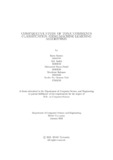| dc.contributor.advisor | Chakrabarty, Amitabha | |
| dc.contributor.author | Razzak, Razia | |
| dc.contributor.author | Sadril, Md. | |
| dc.contributor.author | Shakil, Mahmudul Hasan | |
| dc.contributor.author | Rahman, Mahfuzur | |
| dc.contributor.author | Taki, Sabiha Tul Omman | |
| dc.date.accessioned | 2021-07-15T06:18:46Z | |
| dc.date.available | 2021-07-15T06:18:46Z | |
| dc.date.copyright | 2021 | |
| dc.date.issued | 2021-01 | |
| dc.identifier.other | ID: 16101291 | |
| dc.identifier.other | ID: 16301032 | |
| dc.identifier.other | ID: 16301026 | |
| dc.identifier.other | ID: 16101206 | |
| dc.identifier.other | ID: 17101519 | |
| dc.identifier.uri | http://hdl.handle.net/10361/14810 | |
| dc.description | This thesis is submitted in partial fulfillment of the requirements for the degree of Bachelor of Science in Computer Science and Engineering, 2021. | en_US |
| dc.description | Cataloged from PDF version of thesis. | |
| dc.description | Includes bibliographical references (pages 54-56). | |
| dc.description.abstract | The rapid growth of information technology and the disruptive transformation of
social media have happened in recent years. Websites like Facebook, Twitter, Instagram, where people can express their thoughts or feelings by posting text, photos
or videos, have become incredibly popular. But unfortunately, it has also become
a place for hateful activity, abusive words, cyberbullying and anonymous threats.
There are many existing works in this field but those are not fully successful yet to
provide accuracy in satisfactory level. In this work, we employ natural language processing (NLP) with convolution neural networking (CNN), extreme gradient boosting (XGBoost) and support vector machine (SVM) for segmenting toxic comments
at first and then classifying them in six types from a large pool of documents provided by Kaggle’s regarding Wikipedia’s talk page edits. Using this dataset, the
hamming score of CNN model is 89% ,XGBoost model is 87% and SVM model is
84%. | en_US |
| dc.description.statementofresponsibility | Razia Razzak | |
| dc.description.statementofresponsibility | Md. Sadril | |
| dc.description.statementofresponsibility | Mahmudul Hasan Shakil | |
| dc.description.statementofresponsibility | Mahfuzur Rahman | |
| dc.description.statementofresponsibility | Sabiha Tul Omman Taki | |
| dc.format.extent | 56 Pages | |
| dc.language.iso | en_US | en_US |
| dc.publisher | Brac University | en_US |
| dc.rights | Brac University theses are protected by copyright. They may be viewed from this source for any purpose, but reproduction or distribution in any format is prohibited without written permission. | |
| dc.subject | Cyberbullying | en_US |
| dc.subject | Natural Language Processing | en_US |
| dc.subject | Word Embedding | en_US |
| dc.subject | Convolutional Neural Networks | en_US |
| dc.subject | XGBoost | en_US |
| dc.subject | Support Vector Machine | en_US |
| dc.title | Comparative study of toxic comments classification using machine learning algorithms | en_US |
| dc.type | Thesis | en_US |
| dc.contributor.department | Department of Computer Science and Engineering, Brac University | |
| dc.description.degree | B. Computer Science | |

